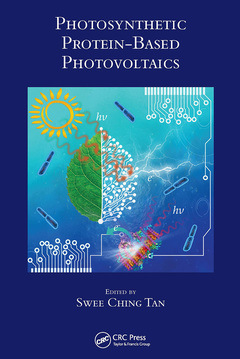Photosynthetic Protein-Based Photovoltaics
Coordonnateur : Tan Swee Ching

Ever since the discovery of the photoelectric effect, researchers have been trying to improve the efficiency of converting sunlight into electricity through photovoltaic devices. Photosynthetic organisms provide clues for harvesting sunlight and storing the energy in chemical forms. This book offers a concise overview of the fundamental concepts of photosynthesis and the emerging photovoltaic technologies, casting light on the symbiotic relation between these spheres of science.
Although there are many books about the fundamentals of photosynthesis and the various aspects of the photosynthetic processes, this is the first volume to focus on the prospects of studying the photosynthetic proteins, understanding and applying their properties to design prospective solar energy conversion devices that are sustainable and efficient. All in all, the book aims to bring together the present know-how on organic photovoltaics and dye-sensitized solar cells with that of the emerging bio-photovoltaics and the underlying physics of photosynthesis to foster a more eclectic research that would converge towards a sustainable energy technology for the future.
The book mainly serves as a bridge to connect biochemists, who study photosynthetic proteins, and physicists and engineers who design and develop photovoltaic devices. Scientists, engineers and students in the fields of photosynthetic research and solar energy research can use this book as a ready reference.
Key selling features:
- Covers both methods and bio-based materials needed to build bio-based photovoltaics
- Focuses on both techniques and applications
- Summarizes the advantages and limitations of various techniques
- Contributors from multiple disciplines integrate the knowledge of photosynthetic proteins and the physics/engineering of photovoltaic devices.
- Includes adaptive designs and techniques used in other types of solar cells to for the design of protein-based PVs
Learning from nature to improve better solar energy conversion devices. Not just plants perform photosynthesis. The reaction centers of photosynthetic organisms. Physics of electron transfer, dynamics, and pathway in different reaction centers. Working principle of some solar cells technology. Photosynthetic-reaction center solar cells. Alternative approaches to design photosynthetic solar cells. Stability issues and method to overcome this method. Using inorganic nano-materials to recreate photosynthetic proteins. Conclusions and future perspectives.
Swee Ching Tan received his bachelor’s degree in
Physics from the National University of Singapore
(NUS). He then worked for Hewlett Packard
Singapore and Ireland as a laser process and equipment
engineer to develop new technologies for silicon
micromachining. At Hewlett Packard, he made
two major contributions that helped the company to
achieve major cost-cutting goals and to increase the
throughput within his department. He was honored
with the Award for Outstanding Achievement for
these contributions to the company. He subsequently
gained PhD admission to the University of
Cambridge’s Electrical Engineering Department
with scholarships from Cambridge Commonwealth Trust and the Wingate
Foundation. His PhD work, under the supervision of Professor Sir Mark Welland,
involved using photosynthetic proteins as light-absorbing materials for solar cells.
After completing his PhD, Dr. Tan moved to the Department of Materials Science
and Engineering at the Massachusetts Institute of Technology to become a postdoctoral
associate working on nanoelectronics. He is currently an assistant professor in
the Department of Materials Science and Engineering with NUS Faculty of
Engineering.
Dr. Tan’s research interests span a wide range of areas in the fields of energy
and environmental sciences. The area of biohybrid photovoltaics is a core expertise
of his research lab with a number of new device architectures developed in recent
years. Dr. Tan’s research group has achieved breakthrough energy-harvesting performances
using natural and engineered photoproteins. His research group is also
working on developing organic ionic conductors and work-function engineering for
applications in energy harvesting and photosensing electronic devices. Bridging the
spheres of energy and environment sciences, the research group is
Date de parution : 08-2022
15.6x23.4 cm
Date de parution : 09-2018
15.6x23.4 cm
Thèmes de Photosynthetic Protein-Based Photovoltaics :
Mots-clés :
RC; Solar Conversion; Solar Cell; Protein-Based Photovoltaics (PV); DSSC; Solar Cells; Natural Photosynthetic System; Bio-Based Photovoltaics; Light Harvesting Complexes; Artificial Photosynthesis; Artificial Photosynthetic Systems; Photoelectrochemical Cells; Opv Device; Di Sheng Lee; Antenna Complexes; Yoke Keng Ngeow; BHJ; Ajay K; Kushwaha; Photoactive Layer; Nagaraju Mokurala; Electron Transfer; Krishnaiah Mokurala; Photochemical Charge Separation; Siddhartha Suman; High PCE; Daize Mo; OSCs; Tianyu Bai; Opv; Leilei Tian; HOPG Electrode; Feng He; Polymer Solar Cells; Michael R; Jones; Interfacial Electronic Structure; Sai Kishore Ravi; BHJ Solar Cell; Vishnu Saran Udayagiri; Excitation Energy Transfer; Anuraj Singh Rawat; American Chemical Society; Charge Separation; Electrochemical Catalytic Activity; Electron Transfer Chain; Homo Energy Level



